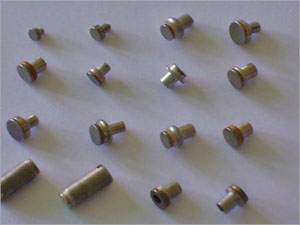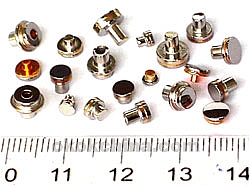Tungsten Heavy Metal Point
Of all pure metals, Tungsten heavy metal has the highest melting temperature of 3,380˚C which gives it excellent arc-erosion resistance. Tungsten heavy metal may develop troublesome oxide films, especially when used as the anode contact in some DC applications. Therefore, tungsten is often used as the cathode contact, and a palladium alloy used as the anode contact. Such a combination also minimizes contact interface resistance and material transfer. Tungsten heavy metal point/contacts are for use in high voltage applications, usually where highly repetitive switching is required.



Tungsten heavy metal point/contact is widely used in relays. The term Relay generally refers to a device that provides an electrical connection between two or more points in response to the application of a control signal. The most common and widely used type of electrical relay is the electromechanical relay or EMR.
The relay tungsten heavy metal point/contacts are electrically conductive pieces of metal which touch together completing a circuit and allow the circuit current to flow, just like a switch. When tungsten point/contacts are open the resistance between the contacts is very high in the Mega-Ohms, producing an open circuit condition and no circuit current flows. When the contacts are closed tungsten point/contact resistance should be zero, a short circuit, but this is not always the case. All relay contacts have a certain amount of "contact resistance" when they are closed and this is called the "On-Resistance", similar to FET's. With a new relay and contacts this ON-resistance will be very small, generally less than 0.2Ω's because the tips are new and clean.






 sales@chinatungsten.com
sales@chinatungsten.com